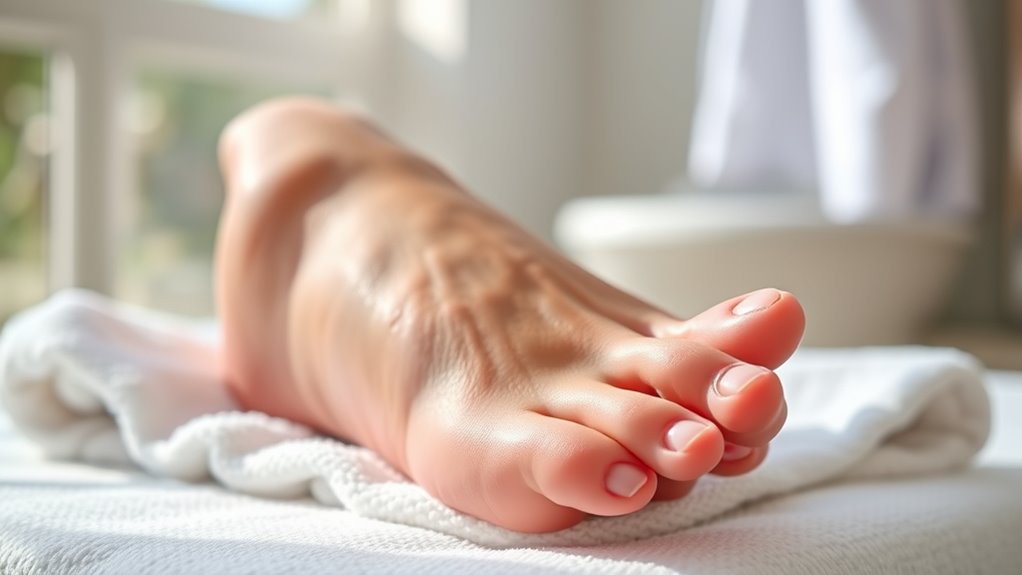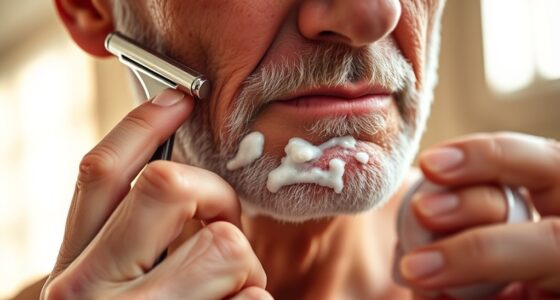To prevent ulcers and infections, you need to prioritize foot health every day. Inspect your feet for cuts, blisters, or redness, and keep them clean and dry. Wear well-fitting shoes with proper support and avoid tight or worn-out footwear. Moisturize to prevent dry skin, trim nails straight across, and look out for early signs of trouble like swelling or warmth. Staying vigilant and following these steps helps protect your feet—discover more ways to keep them healthy.
Key Takeaways
- Conduct daily foot inspections to detect early signs of cuts, blisters, redness, or swelling.
- Maintain good foot hygiene by washing, drying thoroughly, and moisturizing appropriately.
- Wear properly fitted shoes with supportive soles to prevent pressure points and injuries.
- Manage underlying health conditions like diabetes and circulatory issues to reduce ulcer risk.
- Seek prompt medical care for persistent pain, wounds, or signs of infection to prevent complications.
Understanding the Importance of Foot Health
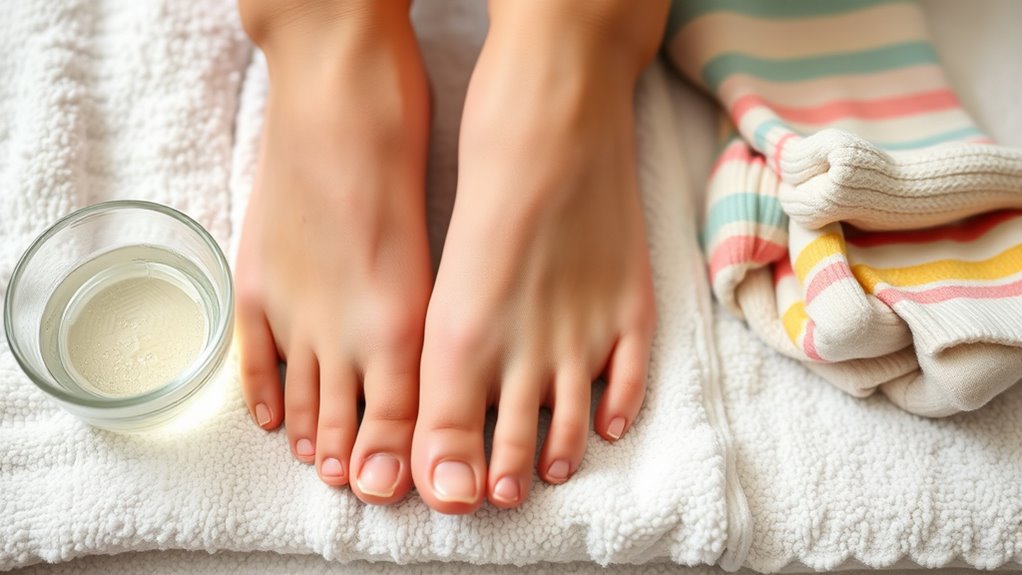
Your feet are the foundation of your body, carrying you through daily activities and supporting your overall mobility. That’s why understanding the importance of foot health is crucial. Good circulation, or circulatory health, ensures your feet receive enough oxygen and nutrients, helping them heal and fight infections. Without proper blood flow, you’re more prone to ulcers and infections. Neuropathy awareness is also essential because nerve damage can diminish sensation, making you unaware of injuries or blisters. Recognizing the signs of nerve issues and maintaining healthy circulation can prevent small problems from worsening. Incorporating air purification into your environment can reduce airborne irritants that may impact respiratory health, indirectly supporting your overall well-being. Keeping your feet healthy isn’t just about comfort—it’s fundamental for your overall well-being. Prioritize foot care to protect your mobility and avoid serious complications down the line.
Daily Foot Inspection Techniques
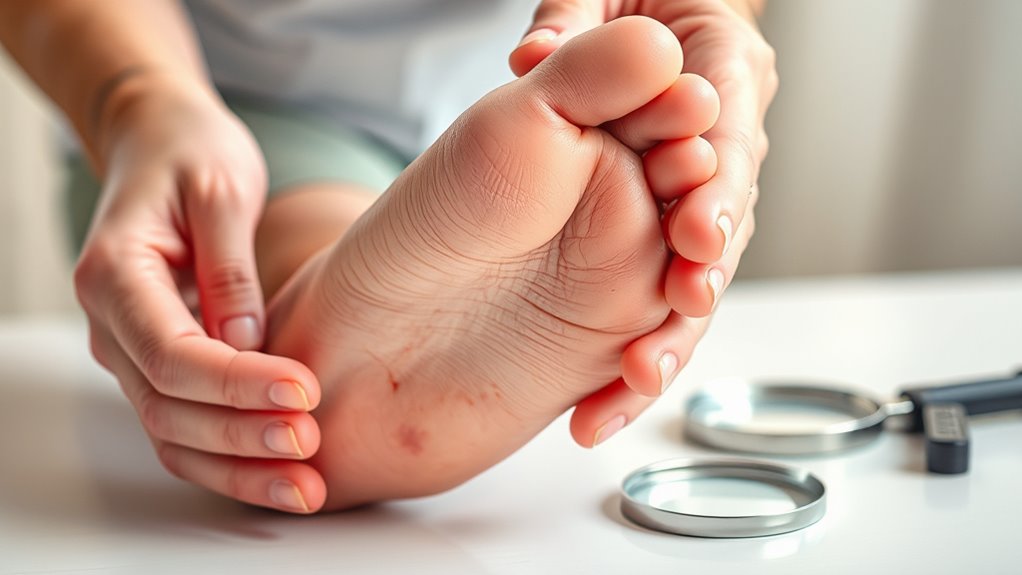
Regularly inspecting your feet each day helps you catch problems early before they become serious. Start by examining every part of both feet, including between your toes, the soles, heels, and around the nails. Look for cuts, blisters, redness, swelling, or sores that could develop into ulcers if untreated. Check your footwear selection to ensure your shoes fit well, don’t cause pressure points, or create friction. Proper footwear helps prevent injuries and reduces the risk of infections. Also, pay attention to foot odor management—persistent odor can signal infections or poor hygiene, so keep your feet dry and clean. Use a mirror if needed to see hard-to-reach areas. Regular inspections empower you to address issues early, keeping your feet healthy and safe. Incorporating foot care routines can further support healthy foot development and prevent complications.
Proper Foot Hygiene Practices
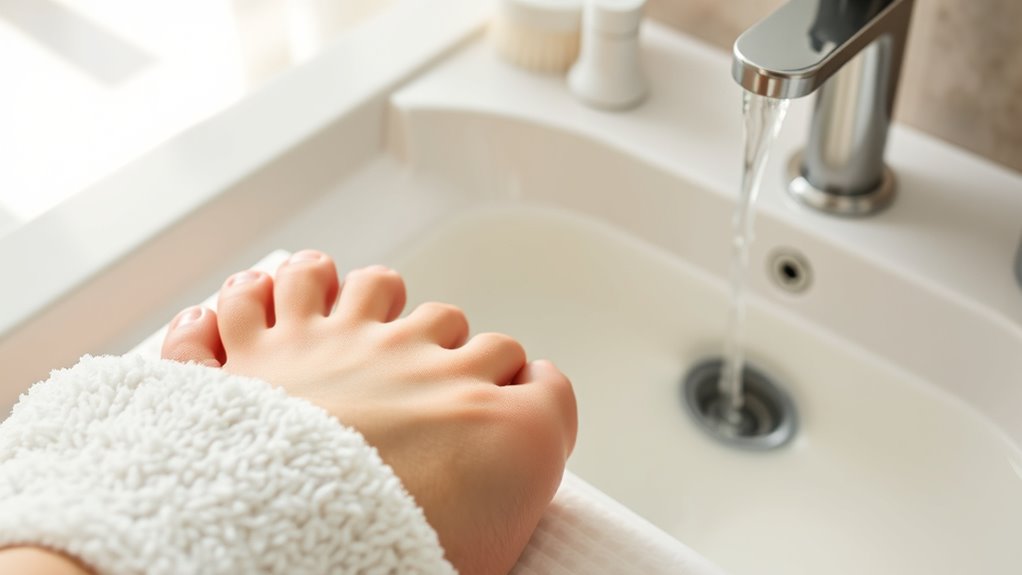
Keeping your feet clean every day helps prevent infections and odors. Make sure to use warm water and gentle soap, drying thoroughly afterward. Also, trim your nails straight across to avoid ingrown issues and keep your feet healthy. Regular inspection of your feet can help identify early signs of foot health issues before they worsen.
Daily Foot Cleaning
Have you ever thought about how simple daily foot cleaning can boost your overall foot health? Regular washing removes dirt, sweat, and bacteria that can cause foot odor and infections. Use warm water and gentle soap to wash your feet thoroughly, paying attention to the spaces between your toes. After drying completely, check for calluses and gently remove any excess with a pumice stone or foot file—this helps prevent thickened skin that can crack or become infected. Proper drying is essential, especially between toes, to prevent fungal growth. Keep your feet fresh and healthy by maintaining this daily routine. Clean feet not only smell better but also reduce the risk of ulcers and infection, supporting your foot health every day.
Proper Nail Care
Did you know that proper nail care is essential for maintaining healthy feet? Keeping your nails clean and trimmed helps prevent problems like nail fungus and infections. When applying nail polish, avoid overusing it or sharing bottles, as this can trap moisture and promote fungus growth. Always remove old polish carefully to prevent buildup. Trim your nails straight across, avoiding cutting too deep into the corners to prevent ingrown nails. Moisturize your nails and cuticles regularly to keep them strong. If you notice discoloration, thickening, or other changes, see a healthcare professional promptly. Good nail hygiene reduces the risk of infections and keeps your feet looking and feeling healthy. Remember, healthy nails are a crucial part of overall foot health. Maintaining proper foot hygiene practices is essential for preventing complications such as ulcers and infections.
Choosing the Right Footwear

When choosing footwear, make sure it fits properly to avoid discomfort and injuries. Look for shoes that provide good support to keep your feet stable throughout the day. Prioritize features like cushioned insoles and arch support to help maintain foot health. Additionally, selecting shoes that promote proper alignment can prevent long-term issues and support overall foot well-being.
Proper Fit Matters
Choosing the right footwear is essential because ill-fitting shoes can lead to discomfort, blisters, and long-term foot problems. Proper fit starts with accurate shoe sizing—your shoes should fit snugly but not tight, with enough room to wiggle your toes. Look for shoes that provide good arch support, which helps distribute pressure evenly and reduces strain on your feet. Avoid shoes that pinch or cause pressure points, as these can lead to ulcers or sores over time. Remember, your feet may change size throughout the day, so try on shoes in the afternoon when your feet are most swollen. Ensuring proper fit is a simple but vital step in preventing foot issues and maintaining overall foot health. Additionally, selecting footwear with appropriate USB-C support can enhance your device compatibility and charging efficiency.
Supportive Shoe Features
What features should you look for to guarantee your shoes provide adequate support? First, ensure they have good heel cushioning to absorb shock and reduce pressure on your feet. Proper heel cushioning helps stabilize your gait and prevents discomfort. Next, check for solid arch support; this helps maintain proper foot alignment and decreases strain on your arches, reducing the risk of ulcers and injuries. The sole should be firm yet flexible enough to accommodate natural foot movement. Avoid shoes with thin soles or inadequate padding, as they can lead to pressure points and skin breakdown. A supportive shoe should fit well, with enough room in the toe box, and stay secure on your heel. Prioritizing these features helps protect your feet and promotes overall foot health. Incorporating durable and supportive footwear can further enhance your foot care routine and prevent common issues.
Moisturizing and Skin Care Tips

Keeping your feet moisturized is essential for healthy skin and preventing issues like cracking or dryness. Choose a good moisturizer suited for your skin type, preferably one with ingredients like urea or glycerin. Regular application helps maintain skin elasticity and reduces the risk of callus buildup, which can lead to discomfort or injury. When applying moisturizer, do so after bathing to lock in moisture, and avoid putting it between your toes to prevent excess dampness. Proper skincare also involves gentle exfoliation to remove dead skin, but don’t overdo it, as that can cause irritation. Consistent moisturizing combined with callus prevention strategies keeps your feet smooth, healthy, and less prone to developing painful blisters or infections. Incorporating healthy fats into your diet can also support skin health from within, helping to keep your skin supple and resilient.
Managing Medical Conditions Affecting Feet

Managing medical conditions that affect your feet is essential for maintaining overall foot health and preventing complications. Conditions like diabetic nerve damage and circulatory issues can lead to numbness, poor healing, and increased infection risk. Recognizing these risks helps you stay alert. Here’s a quick overview:
| Condition | Symptoms | Prevention Tips |
|---|---|---|
| Diabetic Nerve | Numbness, tingling | Regular foot exams, control blood sugar |
| Circulatory Issues | Cold feet, slow healing | Exercise, avoid smoking |
| Both Conditions | Increased ulcer risk | Proper footwear, daily inspections |
| General Care | Pain, swelling | Seek medical advice early |
Stay vigilant, follow your healthcare provider’s advice, and keep your feet protected. Regular monitoring of home heating solutions can also contribute to maintaining a comfortable environment that promotes overall well-being.
When and How to Trim Toenails Safely
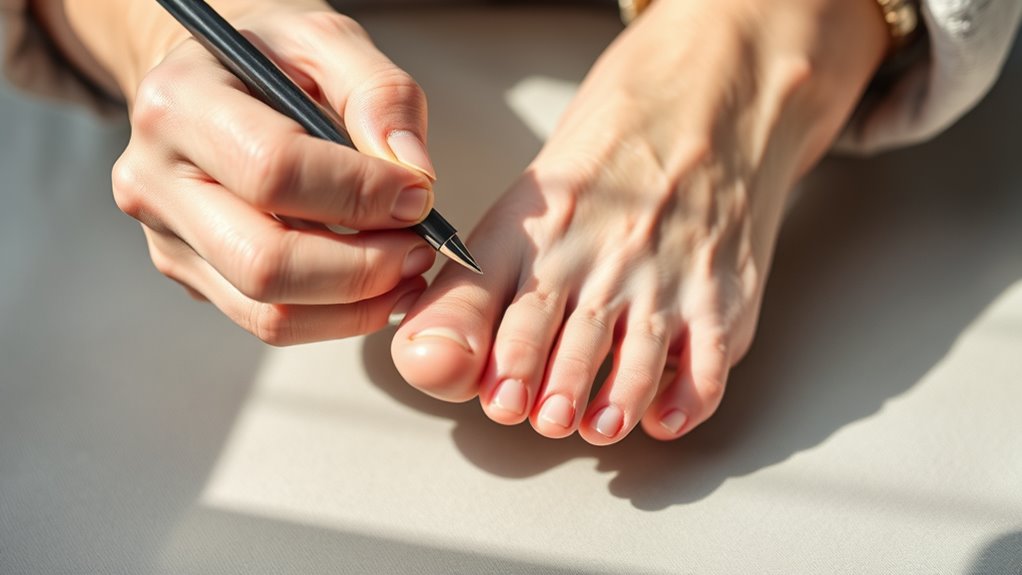
Trimming your toenails safely is essential to prevent infections, ingrown nails, and other foot problems. The right nail trimming techniques involve cutting straight across and avoiding rounded edges, which can cause ingrowth. Use clean, sharp clippers and avoid cutting too close to the skin. It’s best to trim toenails after a bath or shower when nails are softer. Remember, nail hygiene importance can’t be overstated—keeping nails clean and dry reduces bacteria and fungus risks. If you notice thick, discolored, or brittle nails, consult a healthcare provider instead of trying to trim them yourself. Always file sharp edges gently to prevent cuts. Regular, proper toenail care helps maintain healthy feet and prevents complications, especially if you have diabetes or circulation issues. Proper cookie consent management ensures that your browsing experience remains safe and compliant with privacy standards.
Recognizing Signs of Foot Problems Early
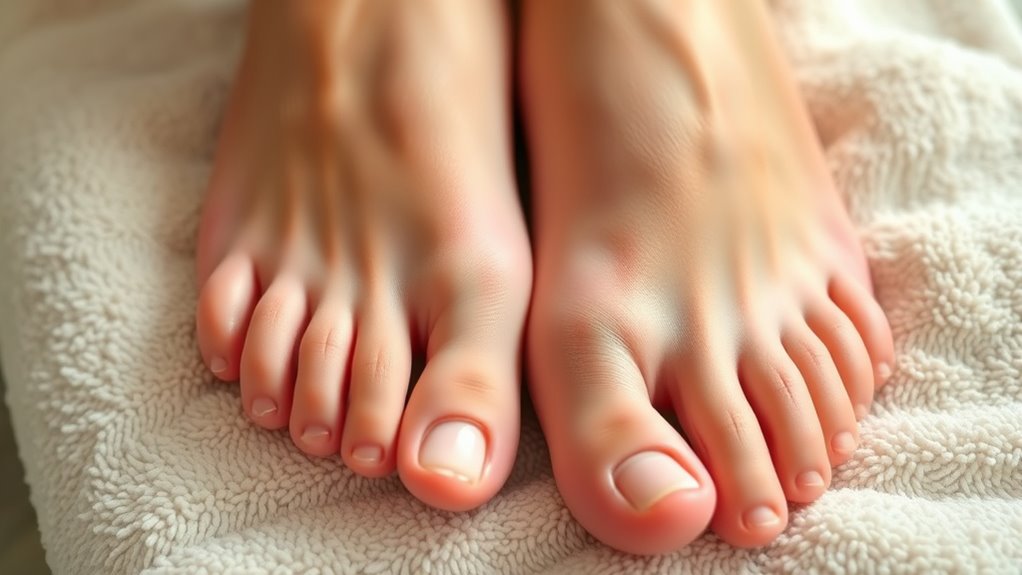
Early detection of foot problems is essential because many issues can develop silently before causing pain or discomfort. Look out for signs like redness, swelling, or warmth, which may indicate infection. Pay attention to callus formation; excessive calluses can lead to skin breakdown if not managed properly. For blister management, notice if you see fluid-filled bumps or torn skin, as these can become infected if ignored. Recognizing these early signs helps prevent ulcers and serious infections. Use proper footwear to reduce callus buildup and avoid blisters. Regularly inspect your feet daily, especially between toes and on soles. Address problems promptly to maintain healthy feet and reduce complications.
| Signs to Watch For | Actions to Take |
|---|---|
| Redness, swelling | Seek prompt care |
| Blisters or torn skin | Manage carefully, keep clean |
| Callus buildup | Use callus prevention techniques |
When to Seek Professional Foot Care

Noticing signs of foot problems early helps prevent complications, but there are times when professional evaluation becomes necessary. If you notice persistent pain, swelling, redness, or a wound that isn’t healing, it’s time to call a podiatrist. Seek immediate help if you see emergency signs like severe pain, bleeding, numbness, or signs of infection such as pus or fever. Don’t ignore new or worsening symptoms, especially if you have diabetes or circulation issues, as these increase risk for serious complications. Early intervention can prevent ulcers and infections from worsening. Trust your instincts—if something feels off or isn’t improving, schedule an appointment with a foot care specialist to get proper treatment and avoid more serious problems later.
Frequently Asked Questions
How Can I Prevent Foot Ulcers if I Have Diabetes?
To prevent foot ulcers if you have diabetes, focus on good diabetes management and foot hygiene. Keep your blood sugar levels controlled to reduce nerve and blood vessel damage. Inspect your feet daily for cuts, blisters, or redness, and wash them with mild soap and water, drying thoroughly. Wear well-fitting shoes and socks, and see a healthcare professional regularly for foot exams. Staying proactive helps protect your feet from complications.
What Are the Best Socks for Preventing Foot Infections?
To prevent foot infections, you should choose moisture-wicking socks that keep your feet dry and reduce bacterial growth. Opt for seamless footwear to minimize irritation and blisters, which can lead to infections. Look for socks made from breathable materials and verify they fit well without tight elastic bands. Regularly changing your socks and inspecting your feet also help prevent infections, keeping your feet healthier and safer.
How Often Should I Replace My Walking Shoes?
You should replace your walking shoes every 300 to 500 miles, or roughly every 6 to 8 months, depending on your shoe’s wear and tear. Regularly check the shoe lifespan by examining the soles and cushioning for signs of deterioration. Worn-out shoes lose support and can lead to foot problems, so replacing them promptly guarantees proper support and reduces the risk of injury.
Are There Specific Foot Exercises to Improve Circulation?
Imagine your feet as busy city streets needing smooth traffic flow. You can improve circulation with simple ankle stretches and toe flexion exercises, like gently moving your ankles in circles or curling and stretching your toes. These movements boost blood flow, helping keep your feet healthy and energized. Incorporate them daily, and you’ll notice your feet feeling lighter and more comfortable, ready to support you every step of the way.
What Should I Do if I Notice a Foot Wound Not Healing?
If you notice a foot wound not healing, you should seek medical advice promptly. Keep the wound clean and covered with an appropriate wound dressing to prevent infection. Watch for infection signs like redness, swelling, or pus. Avoid putting pressure on the wound and follow your healthcare provider’s instructions closely. Early intervention helps prevent complications and promotes proper healing. Don’t delay seeking professional care if healing seems delayed.
Conclusion
Taking care of your feet isn’t just about comfort—it’s about safeguarding your whole well-being. By staying vigilant, practicing good hygiene, and knowing when to seek help, you’re the guardian of your foot health. Think of your feet as the roots of a mighty tree; neglect them, and everything above suffers. So step confidently, knowing that with a little care, you’re paving the way for healthier, happier steps every day.
